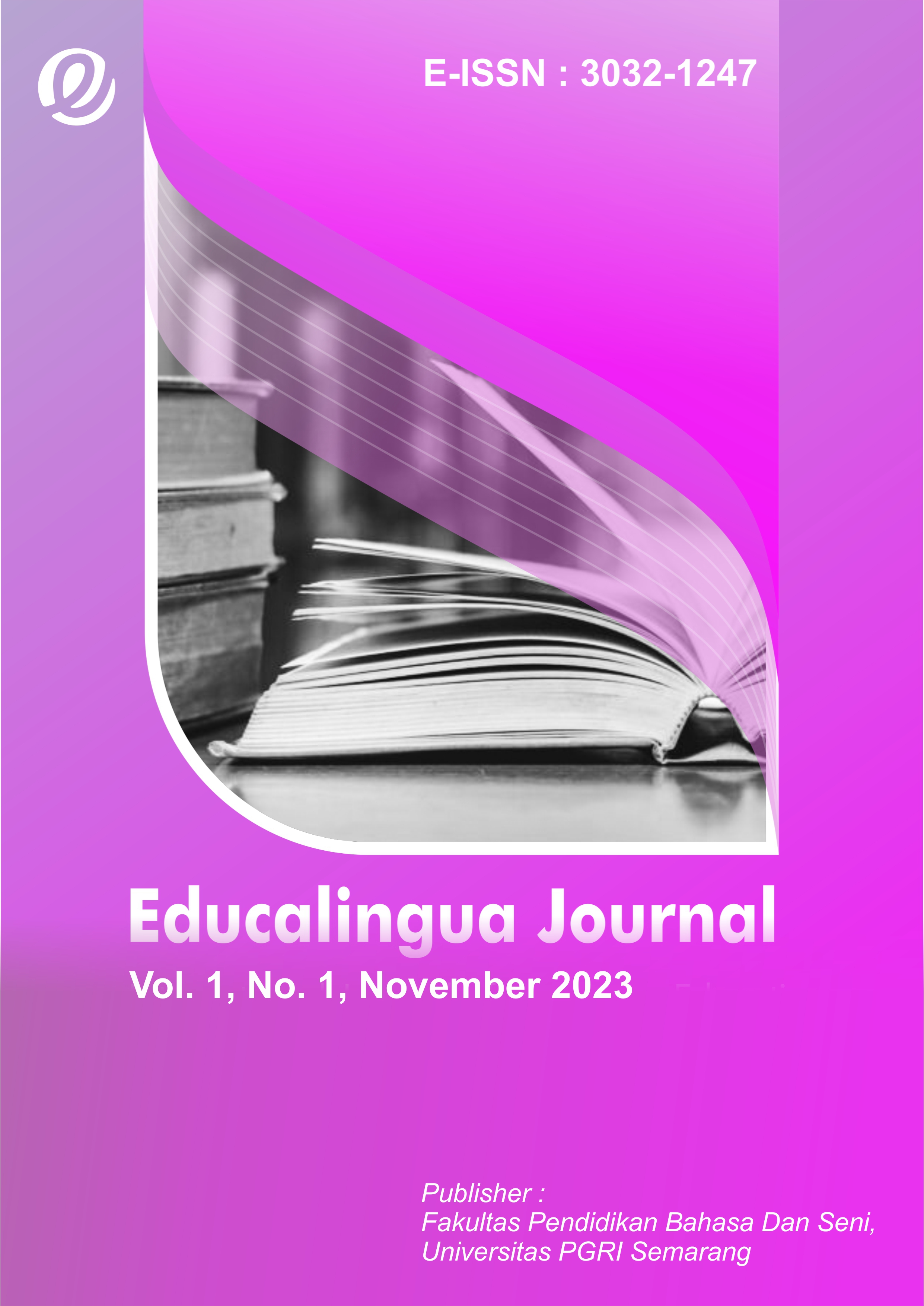Blended Learning in Post-Pandemic Era: from Students’ Perspective
DOI:
https://doi.org/10.26877/educalingua.v1i1.218Keywords:
blended learning, students’ attitude, post-pandemic eraAbstract
Coronavirus disease 2019 stroke the world at the end of 2019 and influenced greatly to all of the sectors. One of the sectors is education. Similarly, when the pandemic ended gradually in 2022, learning returned to normal but required gradual adjustments because both instructors and students had become proficient with online learning. Blended learning is a suitable teaching and learning strategy for the current environment. Blended learning is a combination of online and in-person instruction. Given the widespread use of blended learning today, the researcher intends to investigate students' attitudes toward blended learning in the post-pandemic period. This investigation included 29 students from the English Department at IAIN Ponerogo. The results indicated that the majority of students have a favorable view of blended learning. Two fair attitudes showed in student-student interaction and the contribution of blended learning toward the improvement of their skills.
References
Acar, A. (2013). Attitudes toward blended learning and social media use for academic purposes: An exploratory study. Journal of E-Learning and Knowledge Society, 9(3). https://www.learntechlib.org/p/148260/
Akbarov, A., Gönen, K., & Aydogan, H. (2018). Students’ attitudes toward Blended Learning in EFL Context. Acta Didactica Napocensia, 11(1), 61–68. https://eric.ed.gov/?id=EJ1177040
Al-Shaer, I. (2013). Effects of a blended learning module on EFL students’ attitudes in an introductory reading course in Al-Quds open university setting. International Journal of Language Learning and Applied Linguistics World, 3(4), 224–242. http://citeseerx.ist.psu.edu/viewdoc/download?doi=10.1.1.428.4997&rep=rep1&type=pdf#page=169
Arifa, F. N. (2020). Tantangan pelaksanaan kebijakan belajar dari rumah dalam masa darurat Covid-19. Info Singkat, XII(7), 50–61. https://berkas.dpr.go.id/sipinter/files/sipinter-630-989-20200707165734.pdf
Badawi, M. F. (2009). Using blended learning for enhancing EFL prospective teachers’ pedagogical knowledge and performance. Conference Paper: Learning & Language - The SPirit of the Age. https://eric.ed.gov/?id=ED504993
Bowyer, J., & Chambers, L. (2017). Evaluating blended learning: bringing the elements together. Research Matters: A Cambridge Assessment Publication, 23(1), 17–26. https://learning.huph.edu.vn/pluginfile.php/7529/mod_resource/content/1/375446-evaluating-blended-learning-bringing-the-elements-together.pdf
Cahyono, B. Y., Khotimah, K., Batunan, D. A., & Imamyartha, D. (2023). Workable approaches in EFL teaching mediated by mobile technology during the pandemic and post-pandemic: Indonesian EFL teachers’ experiences and expectations. Call-Ej, 24(1), 137–158.
Eliveria, A., Serami, L., Famorca, L. P., & Cruz, J. S. D. (2019). Investigating students’ engagement in a hybrid learning environment. IOP Conference Series: Materials Science and Engineering, 482(1). https://doi.org/10.1088/1757-899X/482/1/012011
Hubackova, S., & Semradova, I. (2016). Evaluation of blended learning. Procedia - Social and Behavioral Sciences, 217, 551–557. https://doi.org/10.1016/j.sbspro.2016.02.044
Ja’ashan, M. N. H. (2015). Perceptions and attitudes towards blended learning for english courses: A case study of students at university of bisha. English Language Teaching, 8(9), 40–50. https://doi.org/10.5539/elt.v8n9p40
Jamaluddin, D., Ratnasih, T., Gunawan, H., & Paujiah, E. (2020). Pembelajaran daring masa pandemik Covid-19 pada calon guru: hambatan, solusi dan proyeksi. Karya Tulis Ilmiah UIN Sunan Gunung Djjati Bandung, 1–10. http://digilib.uinsgd.ac.id/id/eprint/30518
Nurmasitah, S., Faridi, A., Astuti, P., & Nurrohmah, S. (2019). Students’ perception toward the implementation of blended learning for teaching ESP in faculty of engineering. 379(Veic), 68–73. https://doi.org/10.2991/assehr.k.191217.012
Rapanta, C., Botturi, L., Goodyear, P., Guàrdia, L., & Koole, M. (2021). Balancing technology, pedagogy and the new normal: post-pandemic challenges for higher education. Postdigital Science and Education, 3(3), 715–742. https://doi.org/10.1007/s42438-021-00249-1
Saboowala, R., & Manghirmalani-Mishra, P. (2020). Perception of In-Service Teachers Towards Blended Learning as the New Normal in Teaching-Learning Process Post COVID-19 Pandemic.
Smith, K., & Hill, J. (2019a). Defining the nature of blended learning through its depiction in current research. Higher Education Research and Development, 38(2), 383–397. https://doi.org/10.1080/07294360.2018.1517732
Smith, K., & Hill, J. (2019b). Defining the nature of blended learning through its depiction in current research. Higher Education Research & Development, 38(2), 383–397. https://doi.org/10.1080/07294360.2018.1517732
Strauss, V. (2012). Three fears about blended learning. The Washington Post. https://www.washingtonpost.com/blogs/answer-sheet/post/three-fears-about-blended-learning/2012/09/22/56af57cc-035d-11e2-91e7-2962c74e7738_blog.html
Tang, C., & Chaw, L. (2013). Readiness for blended learning: Understanding attitude of university students. International Journal of Cyber Society and Education, 6(2), 79–100. https://www.learntechlib.org/p/209223/
Zhu, Y., Au, W., & Yates, G. C. R. (2013). University students’ attitudes toward online learning in a blended course. Australian Association for Research in Education. https://eric.ed.gov/?id=ED603297





